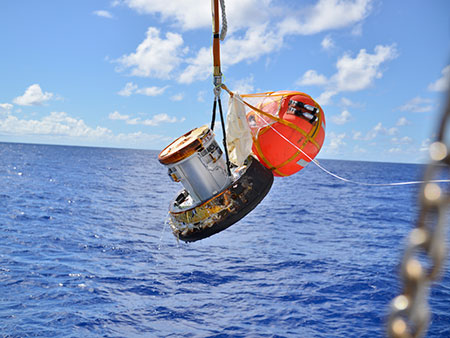About us
JAXA Aviation helps to create a safer and more prosperous society with aeronautics-related research and development activities.
FLIGHT PATH No.22 | 2018 WINTER
<Kármán line>
Leveraging CFD simulation technology at hypervelocity speeds to hone spacecraft re-entry technology
Interviewee:MATSUYAMA Shingo
Researcher, Numerical Simulation Research Unit, Aviation Technology Directorate
Extraordinary phenomena occur in the world of hypervelocity flight
Computational fluid dynamics (CFD) technology is used to analyze and simulate various phenomena that take place around an object traveling through a fluid. Researchers in a wide range of fields already apply this technology to develop safer and higher-performing aircraft with greater efficiency. For example, FaSTAR, which was developed by JAXA and is one of the world's fastest fluid analysis tools, has been used in the development of many aircraft and spacecraft.
However, to develop things like hypersonic aircraft, which is increasingly drawing attention from researchers around the world, and space planes that can reach and return safely from the Earth's orbit, a new type of CFD technology is required—one that is different from the kind used to develop transonic aircraft and supersonic aircraft.
“With hypersonic aircraft that fly at a speed of Mach 5 and can cross the Pacific in two hours,” explains MATSUYAMA Shingo, “or atmospheric re-entry vehicles that travel at hypervelocity speeds ranging from Mach 10 to Mach 30, you start to observe physical phenomena totally unlike what you normally see.” With the aim of studying hypervelocity phenomena, JAXA is currently developing JONATHAN*1, a program designed to analyze thermochemical nonequilibrium flow*2.
In pursuit of greater accuracy and versatility for ease of use
In fields that deal with extremely fast flow, like the kind seen with spacecraft, CFD was slow to find practical applications compared to the aviation field due to technical difficulties. Without the ability to analyze phenomena at hypervelocity speeds, it is impossible to fully predict the physical phenomena that occur around an airframe, which may lead to the occurrence of the unexpected. Back in the early 1980s, researchers identified problems with attitude control at the time of space shuttle re-entry, and the study of flow at hypervelocity speeds began to show rapid advancement from around that time.
“Atmospheric entry capsules returning from space, for instance, reach speeds of over 5 to 7 km per second,” says MATSUYAMA, who has been developing and refining JONATHAN over the past dozen years since when he joined JAXA in 2004. “At such extremely high speeds, the physical properties of air change, and it is impossible to do an accurate simulation without taking account of the vast amounts of thermal energy that is created as a result.”
“We have been striving to achieve greater accuracy while adding new features, so that JONATHAN will serve as a platform for demonstrating the validity of JAXA's research results in other areas as well, instead of just my own research field. At the same time, we have invested tremendous effort into making JONATHAN a highly versatile tool that can be used by private businesses or anyone in a wide range of fields, not just experts in a handful of aerospace fields, and without the need to know what's inside this extremely complicated program.”
As one example of the fruit of this endeavor, on November 11, 2018 (Japan time), the HTV Small Re-entry Capsule (HSRC) carried onboard H-II Transfer Vehicle “Kounotori 7” (HTV7) successfully brought experiment samples from the International Space Station (ISS) back to Earth. JONATHAN played a part in designing and developing this capsule.
JONATHAN is also used, for a fee, as a design and development tool in a plan proposed by ALE Co., Ltd. to create artificial meteor showers, which was chosen for JAXA's innovative satellite technology demonstration program. Application of this technology is spreading to areas outside JAXA as well, in keeping with the focus on an “exit-oriented” (i.e., application-oriented ) approach as set out in JAXA's Third Mid-term Plan.

Retrieving the HTV Small Re-entry Capsule (HSRC) (off the coast of Minamitorishima, Ogasawara Islands, Tokyo)
Honing Japan's re-entry technology
“Many of the phenomena that occur in a hypervelocity flow remain a mystery as to how they occur,” says Matsuyama. “What's really exciting about this research is in unraveling that mechanism through simulation. As one effort along that line, we are currently working on the simulation of hypervelocity turbulence. We believe this work has greater implications than simply revealing the mechanism behind how turbulence occurs in a hypervelocity environment. We believe that, perhaps, it might be possible to predict and control hypervelocity flows, or to manipulate the flows and make them take on desirable properties.”
JAXA is already working on research in areas such as simulation of Mars atmospheric entry capsules. This is an essential technology for future manned exploration of the moon and planets. Japan is one of the few countries that currently possess the technology to re-enter the Earth's atmosphere from space. MATSUYAMA shares his ambitions for the program. “We intend to make further improvements to JONATHAN so that we can use this sophisticated technology that originated in Japan to play a part in developing re-entry technology, and give it greater versatility to be able to make valuable contributions to space exploration activities.”
*1: Even more highly accurate prediction is achieved by combination with SPRADIAN, a tool designed to evaluate radiation heating that becomes hard to ignore at hypervelocity speeds exceeding 10 km per second. For more information.
*2: Refers to a flow field where extremely high temperatures cause excitation of rotation and vibration energy in nitrogen and oxygen molecules, and give rise to thermochemical reactions such as thermal dissociation and ionization of molecules.
The Kármán line is a theoretical boundary separating the earth's atmosphere from outer space. By forging connections across the divide between aviation and space, JAXA is working to provide society with valuable benefits. This section looks at how technologies from the Aviation Technology Directorate are bridging that gap and making a difference in the space field.